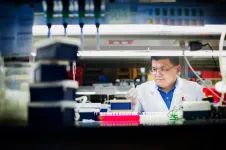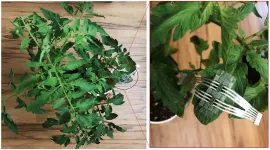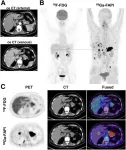(Press-News.org) Immunologists at St. Jude Children's Research Hospital have identified a biological pathway that selectively controls how key immune cells, called T follicular helper cells, mature into functional components of the immune system.
The finding offers the promise of developing drugs to activate the metabolic pathway to enhance the effectiveness of vaccines, including those that protect against COVID-19. Such medications could stimulate the immune system to respond more vigorously following immunization to produce more antibodies against a virus or bacterium.
The work also lays the foundation for drugs that dial down the pathway to alleviate autoimmune diseases such as lupus. In such disorders, an overactive immune system produces antibodies that attack the body's own tissues.
Led by Hongbo Chi, Ph.D. of the Department of Immunology, the researchers published their findings today in Nature.
Regulating the adaptive immune response
Chi and colleagues identified a metabolic control pathway that selectively regulates the development of specialized immune cells in the adaptive immune system. These cells are called T follicular helper cells.
The adaptive immune system is so named because when the body is infected by viruses or bacteria, it learns to target and attack them. T follicular helper cells activate the component of the adaptive immune system called humoral immunity. While humoral immunity attacks invaders circulating outside cells largely via the generation of antibodies, the other adaptive immune system component, cellular immunity, targets invaders inside infected cells.
In their experiments, the researchers sought to discover whether a metabolic control pathway existed that modified the T follicular helper cells to activate them. When such cells are activated, they help antibody-producing cells, called B cells, to mature and to generate infection-fighting antibodies.
Discovering a key pathway
To discover a possible control pathway, Chi and his colleagues used genetic techniques to delete in the T cells multiple enzymes known to be elements of such metabolic control pathways. Then, the scientists introduced the deletion-engineered T cells into mice followed by infection with a virus and tested whether the T cells lacking the enzyme were functional.
Their experiments revealed that one metabolic control pathway, called the CDP-ethanolamine pathway, selectively regulated the T follicular helper cells.
"This finding was a big surprise," Chi said. "First of all, this pathway was considered to have a housekeeping function leading to the production of building blocks for the cell membrane. But we discovered that it has a major signaling function. And secondly, we were surprised that this pathway--and not other parallel pathways of this type--was the only one involved in regulating T follicular helper cells."
As a complementary method to determine if the pathway selectively regulated the T follicular helper cells, the researchers deleted each of the key enzymes they identified in the CDP-ethanolamine pathway. They found that deletion of these enzymes, but not those of other parallel regulatory pathways, selectively impaired development of the T follicular helper cells, but not overall immune function.
Importantly, said Chi, those key enzymes could be targets for drugs that either enhance or inhibit the pathway, and thus the activity of the T cells.
"We are now exploring whether we can enhance the effectiveness of vaccines by using drugs that activate the pathway, to help these T cells mobilize the immune system to generate antibodies in response to a vaccine," he said.
"On the other hand, to treat autoimmune disease, we're interested in developing new ways to inhibit this pathway," he said. "This approach is promising because we know that such activation or inhibition is highly selective for T follicular helper cells and would not affect other immune functions."
The researchers are also delving into the structural mechanisms by which the enzymes work--insights that could offer such drug targets, Chi said.
INFORMATION:
Authors and funding
Guotong Fu, Ph.D., St. Jude Immunology, is the first author. The other St. Jude authors are Clifford Guy, Nicole Chapman, Gustavo Palacios, Jun Wei, Peipei Zhou, Lingyun Long, Yong-Dong Wang, Chenxi Qian, Yogesh Dhungana, Hongling Huang, Anil KC, Hao Shi, Sherri Rankin, Scott Brown, Amanda Johnson, Randall Wakefield, Camenzind Robinson, Jiyang Yu and Suzanne Jackowski. Additional authors are Xueyan Liu, University of New Orleans, and Anthony Sheyn, University of Tennessee Health Science Center.
The research was supported in part by the National Institutes of Health (AI105887, AI131703, AI140761, AI150241, AI150514, CA221290), Lupus Research Alliance and ALSAC, the fundraising and awareness organization of St. Jude.
URBANA, Ill. ¬- Bioenergy from crops is a sustainable alternative to fossil fuels. New crops such as energycane can produce several times more fuel per acre than soybeans. Yet, challenges remain in processing the crops to extract fuel efficiently.
Four new studies from the University of Illinois explore chemical-free pretreatment methods, development of high-throughput phenotyping methods, and commercial-scale techno-economic feasibility of producing fuel from energycane in various scenarios.
The studies are part of the ROGUE (Renewable Oil Generated with Ultra-productive Energycane) project at U of I. ROGUE focuses on bioengineering ...
What The Study Did: Wearable sensor data were used to examine the duration and variation of recovery among COVID-19-positive and COVID-19-negative participants.
Authors: Jennifer M. Radin, Ph.D., M.P.H., of the Scripps Research Translational Institute in La Jolla, California, is the corresponding author.
To access the embargoed study: Visit our For The Media website at this link https://media.jamanetwork.com/
(doi:10.1001/jamanetworkopen.2021.15959)
Editor's Note: The article includes conflict of interest and funding/support disclosures. Please ...
What The Study Did: The characteristics and factors associated with deaths among individuals detained in U.S. Immigration and Customs Enforcement (ICE) facilities from 2011 to 2018 were examined in this study.
Authors: Parveen Parmar, M.D., M.P.H., of the Keck School of Medicine of the University of Southern California in Los Angeles, is the corresponding author.
To access the embargoed study: Visit our For The Media website at this link https://media.jamanetwork.com/
(doi:10.1001/jamanetworkopen.2021.16019)
Editor's Note: The article includes conflict of interest and funding/support disclosures. Please see the article for additional information, including other authors, author contributions and affiliations, conflict of interest and financial disclosures, and funding ...
Diversification in the sourcing of food into cities can go a long way to tempering "food shock" -- a sudden drop in food supply due to unforeseen events, according to a team of researchers from Penn State and Northern Arizona University, who developed a statistical risk model linking supply chain diversity to the probability of a city experiencing food shocks.
"The model is simple, operationally useful and hazard-agnostic," the researchers report today (July 8) in Nature. "Using this method cities can improve their resistance to food supply shocks with policies that increase the food supply chain diversity."
The researchers investigated four types of food -- crops, live animals, feed and meat -- over a four-year period from ...
A massive explosion from a previously unknown source - 10 times more energetic than a supernova - could be the answer to a 13-billion-year-old Milky Way mystery.
Astronomers led by David Yong, Gary Da Costa and Chiaki Kobayashi from Australia's ARC Centre of Excellence in All Sky Astrophysics in 3 Dimensions (ASTRO 3D) based at the Australian National University (ANU) have potentially discovered the first evidence of the destruction of a collapsed rapidly spinning star - a phenomenon they describe as a "magneto-rotational hypernova".
The previously unknown type of cataclysm - which occurred barely a billion years after the Big Bang - is the most likely explanation ...
Our cells fight microbial invaders by engulfing them into membrane sacs - hostile environments in which pathogens are rapidly destroyed. However, the pathogen Salmonella enterica, which grows and reproduces inside our cells, has evolved ways to detoxify such hostile compartments, turning them into a comfortable home where Salmonella can survive and thrive.
A team of scientists led by EMBL group leader Nassos Typas has uncovered new details of Salmonella´s survival strategies. The researchers analysed protein interactions in Salmonella-infected cells to identify the diverse biological processes of the host cell that the bacterium uses. Salmonella targets and modifies cellular protein machineries and pathways, ...
Scientists from Trinity College Dublin are homing in on a recipe that would enable the future production of entirely renewable, clean energy from which water would be the only waste product.
Using their expertise in chemistry, theoretical physics and artificial intelligence, the team is now fine-tuning the recipe with the genuine belief that the seemingly impossible will one day be reality.
Initial work in this area, reported just under two years ago, yielded promise. That promise has now been amplified significantly in the exciting work just published in leading journal, Cell Reports Physical Science.
Energy ...
Researchers from North Carolina State University have developed a patch that plants can "wear" to monitor continuously for plant diseases or other stresses, such as crop damage or extreme heat.
"We've created a wearable sensor that monitors plant stress and disease in a noninvasive way by measuring the volatile organic compounds (VOCs) emitted by plants," says Qingshan Wei, co-corresponding author of a paper on the work. Wei is an assistant professor of chemical and biomolecular engineering at NC State.
Current methods of testing for plant stress or disease involve taking plant tissue samples and conducting an assay in a lab. However, this ...
The Hikurangi Margin, located off the east coast of the North Island of New Zealand, is where the Pacific tectonic plate dives underneath the Australian tectonic plate, in what scientists call a subduction zone. This interface of tectonic plates is partly responsible for the more than 15,000 earthquakes the region experiences each year. Most are too small to be noticed, but between 150 and 200 are large enough to be felt. Geological evidence suggests that large earthquakes happened in the southern part of the margin before human record-keeping began.
Geophysicists, geologists, and geochemists from throughout the world have been working together to understand why this plate boundary behaves as it does, producing both imperceptible silent earthquakes, but also potentially major ...
Reston, VA--For patients with pancreatic ductal adenocarcinomas (PDAC), molecular imaging can improve staging and clinical management of the disease, according to research published in the June issue of The Journal of Nuclear Medicine. In a retrospective study of PDAC patients, the addition of PET/CT imaging with 68Ga-FAPI led to restaging of disease in more than half of the patients, most notably in those with local recurrence.
PDAC is a highly lethal cancer, with a five-year survival rate of less than 10 percent. Optimal imaging of PDAC is crucial for accurate initial TNM (tumor, node, metastases) staging and selection ...







